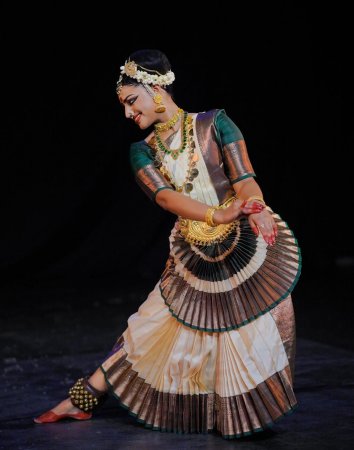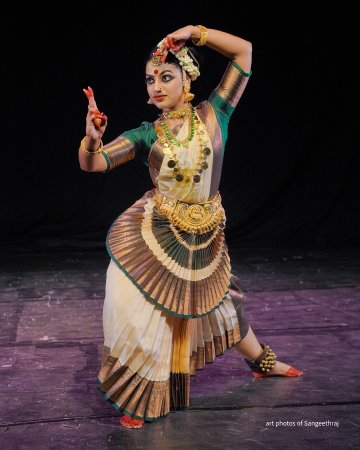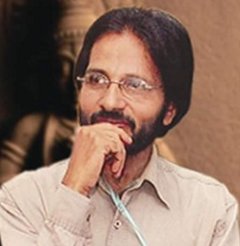
|   |

|   |
A delectable aesthetic treat - V. Kaladharan e-mail: kaladh@rediffmail.com August 20, 2024 Sandwiched between Kutiyattam, the esoteric Sanskrit Theatre tradition and Kathakali, the globally hailed classical dance-drama, Mohiniyattam, the woman-centric lasya heritage of Kerala, didn't have the desired degree of exposure for a long period of time. To add insult to injury, its history is replete with ambiguities and incertitude. However with its resurrection by poet laureate Vallathol Narayana Menon at the Kerala Kalamandalam in the early 1930's, Mohiniyattam regained its visibility and recognition. In the second half of the last century, the dance form could boast of a tremendous outreach consequent upon diverse developments such as the striking entry of two non-native dancers. One of them was Dr. Kanak Rele who founded Nalanda Dance Research Centre in Mumbai. Dr. Sunanda Nair based in Houston is her distinguished disciple who carries on the legacy of her Guru with an irrepressible passion. Sunanda's disciple, Meghana Muraleedharan, recently presented a Mohiniyattam recital at the Mini Theatre of the Sangeetha Nataka Academy, Thrissur. It was, in one word, a delectable aesthetic treat.  Meghana began her recital with Ganapathi sthuthi in which she worshipped Lord Ganesha by employing multiple metaphors and images associated with the deity. Sunanda's rendition of the chollus imparted an indigenous flavor to the item that lay emphasis on Suddha Nritta. Meghana then moved on to the presentation of Swathy Thirunal's well known Kirthana, Gopalakapahimam in raga Revagupthi. The terse vinyasas included Gajendra moksha, Kaliya mardana and Kuchelopakhyana. Interestingly there was no attempt on the part of the dancer to dramatize the different contexts trespassing the organic structure of the dance form itself. The very next item was a visual delineation of an immensely popular Malayalam film song, Kesadipadam thozhunnen Kesava dating back to the 1970's. Penned by P. Bhaskaran, the song is filled with riveting metaphors to describe the Vanamali from head to foot. Set to ragamalika (Mohanam, Sarangam & Shree) by B.A. Chidambaranath, the vocalist here, Sujesh Menon, didn't strictly adhere to its original simplicity discernible in the rendition of S. Janaki. He enriched the lines with classical flourishes in tune with the glorious visualization. With the result, the item received a refreshing tone altogether.  Through Ardhanareeswara, the dancer convincingly portrayed lasya and thandava, symbolizing Goddess Parvathi and Lord Shiva respectively. Chandana charchita from the Gita Govinda bore the glow of Rasaleela as Meghana depicted Krishna encircled by the impassioned Gopikas smitten with love. The dancer navigated the contours of Sringara without going overboard. The finale was a piece from the item, Jeeva, the syllables of which are a contribution of the late Kavalam Narayana Panikkar to the modern repertoire of Mohiniyattam. But for the Ashtapadi, all the items presented were choreographed by Sunanda Nair. Incidentally, Chandana charchita was a masterpiece of the late Kanak Rele. Sunanda's choreographic dexterity made Meghana's recital memorable. Adi tala and mid-tempo prevailed throughout. Khanda nata and Marma tala (14 beats) did make a short visit in between. Talented artistes wielded a host of musical instruments viz. mridangam, maddalam, edakka, flute and the veena. Initially, I feared the music would end up as a cacophony submerging the visual frames. Fortunately that was not to be. Mention must be made here about the sounds of maddalam and edakka that provided a distinct aural experience when played independently and in harmony with the other musical instruments. Of course, the music, by and large, was a wee bit louder than it should have been. Still it didn't mar the finer aspects of the dance. I won't, under any circumstances, argue or conclude that the performance was blemishless. Meghana being a young, upcoming dancer, I have refrained from dissecting her artistry part by part. She is yet to major in her chosen field. The fact that she enjoyed every bit of what she did on stage made me write this review. Endowed with a fine figure, highly articulate upangas and command over rhythm, Meghana, I hope, will be able to carve out a space of her own in the field of Mohiniyattam.  Former Deputy Registrar of Kerala Kalamandalam, V Kaladharan is also an art critic. He has published several articles at the academic level. 'From Meditative Learning to Impersonal Pedagogy' was published in an anthology 'Qui Parley' initiated and released by scholars and writers from the University of California, Berkeley. His articles on Indian performing arts and literature regularly appear in magazines and journals, and in the Friday Page of The Hindu. |